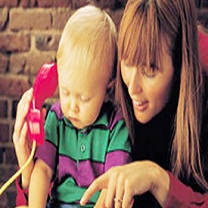About PACT
Trial background
The Pre-school Autism Communication Trial was a Medical Research Council randomised controlled trial that ran between 2006 and 2010. It tested a parent-mediated communication-based intervention for young children with autism. The trial was a major scientific success and constitutes one of the largest autism intervention studies completed internationally. The project resulted from a major collaboration between The University of Manchester, University of Newcastle, Institute of Child Health London, Guys Hospital London, King’s College London, Stockport Primary Care Trust, Lewisham Primary Care Trust, Southwark Primary Care Trust and North Tyneside Primary Care Trust.
The primary results are now published in The Lancet. Our other dissemination activities can be seen here. Latest news - Professor Jonathan Green's blog here.
What is the PACT treatment?
Autism is a severe and chronic neurodevelopmental disability affecting individuals from early childhood through adult life. Although there have been many claims of effective treatment for autism, there has been very little systematic research evidence to support most treatments.
The PACT study tested a treatment that aimed to enhance parent-child communication in autism and the social and language development of the child. The approach aims to help parents adapt their communication style to their child’s impairments and respond to their child with enhanced sensitivity and responsiveness. There is a focus on increasing shared attention through eye-gaze, sharing, showing and giving. Parents are encouraged to use language that is tailored to their child’s level of understanding. Parents are also introduced to strategies that facilitate child communication and participation, such as action routines, repeated verbal scripts and the use of elaborations, pauses, and teasing. Here is a description of PACT therapy.
The research process
Consent and baseline assessments
Families with a young child with autism were referred from local clinical teams. Participants were given detailed information about the study and time to decide whether or not to take part. Participation was entirely voluntary. A member of the research team met with parents and child and carried out a variety of assessments. During these assessments the researcher made a detailed assessment of the child’s social and communication abilities, their level of language and their general level of learning ability. Through questionnaires and interviews with the family, we gathered detailed information about the child’s development and current functioning at home, experiences as parents and as a family, the parents' understanding of their child’s problem, and the impact that these have had on their lives. We looked at the way parents and child communicate and interact together, including observations of the typical communication style of the parent. We also gathered information about any help or services that the family may have received over the previous six months and additional expenses that may have incurred as a consequence of the child’s difficulties.
Treatment allocation
After the initial assessments, families were randomly allocated into one of two groups. This allocation was random allocation design in which the groups were selected by a computer programme that contained no information about the individuals. Allocation was completely by chance and did not depend on characteristics of either the parents or the child.
One received routine clinical care and the second group also received routine clinical care, but with the addition of the trial communication intervention. Thus all families continued with regular treatments supplied by their health and educational services. Half the families, in addition, received the communication therapy described below.
Follow-up assessments
After 7 months there was another short assessment for all families which involved an interview and a video assessment of the child’s communication. After about 13 months we repeated the assessments that we conducted at the beginning of the study to find out how the child and family progressed during that time. All families received a detailed report summarising the assessments.
For more information about the methodology of the PACT study, please read our protocols at the bottom of this page.
Findings
The study recruited and randomly allocated 152 families with children with autism between the ages of two and five years across the three sites (Manchester, Newcastle, London). Half of these families attended PACT therapy sessions over the course of 12 months. The study found that parents who took part in the additional therapy sessions were successful at adapting their style of interacting with their child and in turn their child communicated more with speech and gestures with their parent. These parents also reported improvements in their child’s language abilities.
Many children in both groups showed improvements in their communication and social interaction over the course of the 13 months, as measured by the play-based ADOS assessment. However, the intervention did not help children to interact better with adults outside of the family, that is, their communication improvements did not seem to generalise to interactions with the research team or with school staff.
To see the international reaction to the PACT study go to Commentary at the bottom of the page.
A video of the research lead, Professor Jonathan Green, discussing the trial and its results can be seen here.
Implications
The study made an important contribution to the growing evidence around treatments for autism. It used rigorous methodology, recruited a large number of families and the vast majority of families stayed involved throughout the process. On the basis of the findings we were not able to recommend the addition of the PACT intervention into general services for the purpose of reducing autism symptoms. However, the PACT therapy can be recommended for the purposes of improving parent-child two-way play and communication in ways that are likely to be positive for parents themselves and that may have longer term benefits for the child. For this reason we are commencing a longer-term follow-up of the PACT families to find out whether this is the case. Read about it more on the PACT 7-11 page.
Commentary
- Autism Crisis (blog) - International reaction to the trial
- Thurm and Spence commentary (PDF, 268KB)
PACT Protocols
- PACT: Trial protocol (PDF, 170 KB)
- PACT: Lancet protocol (PDF, 72 KB)


